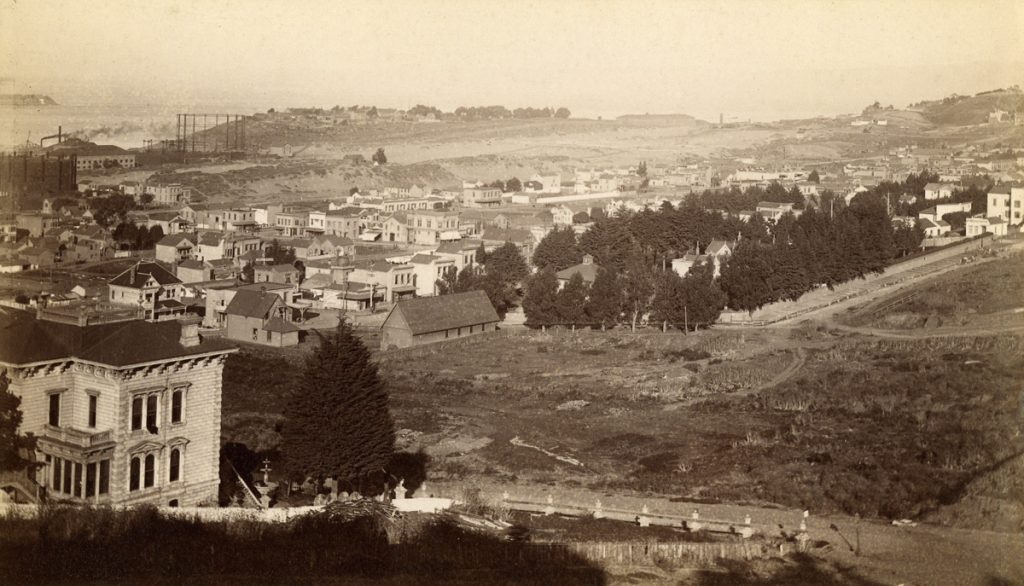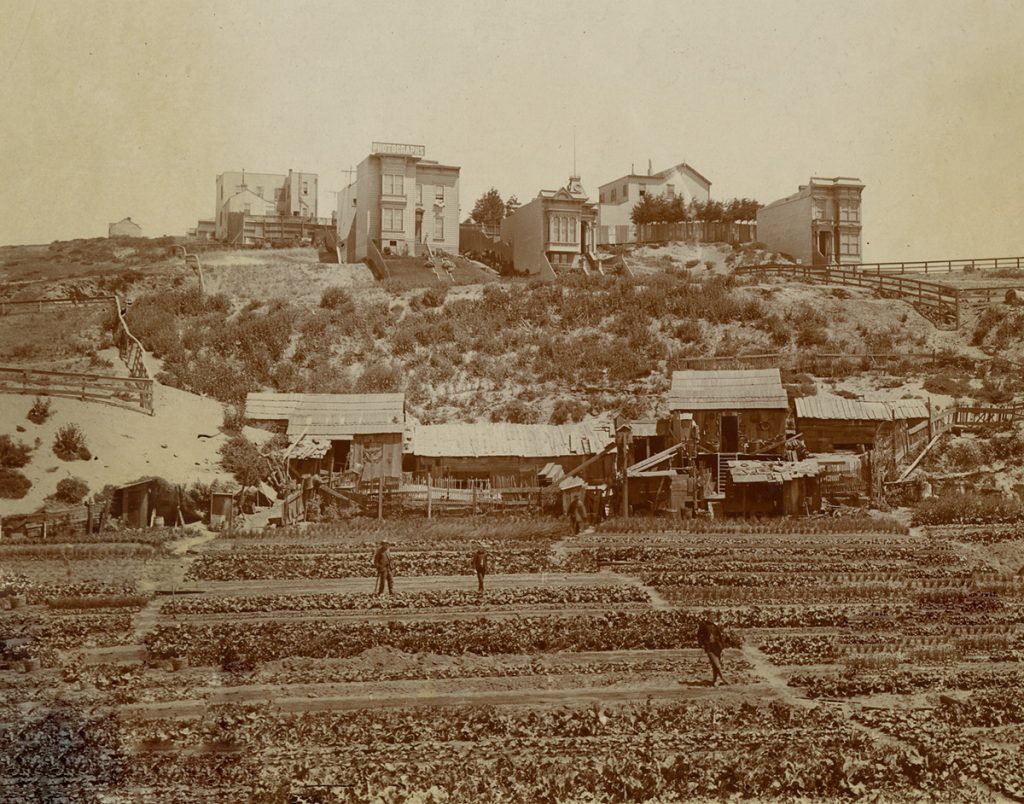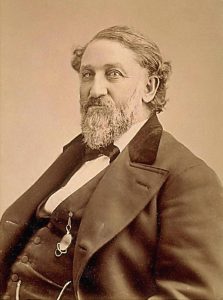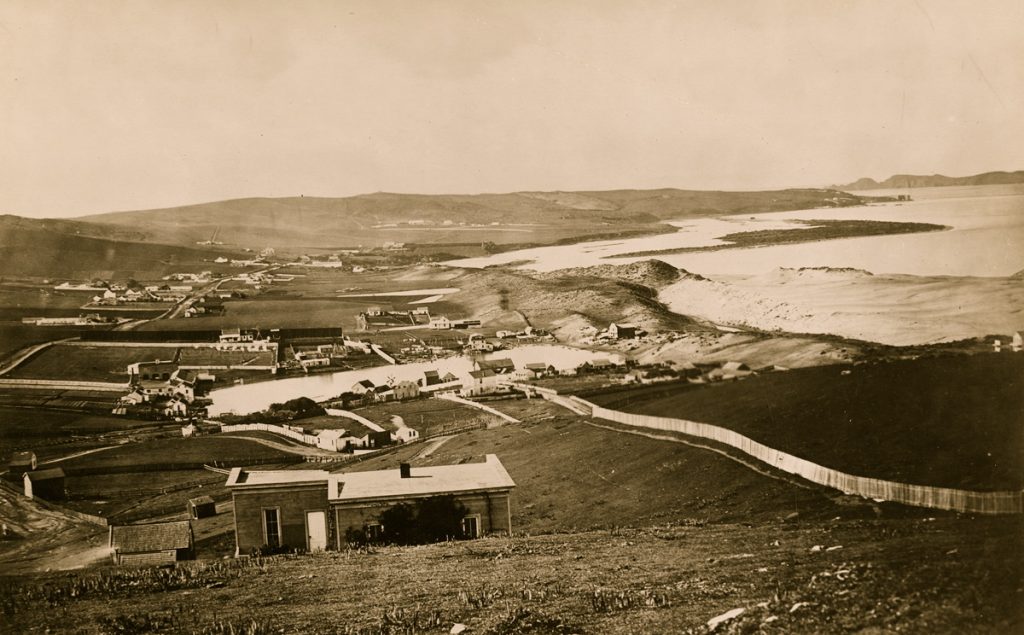
In this view from Vallejo and Scott Streets, circa 1893, Frank Pixley’s estate occupied the entire forested block bounded by Green, Steiner, Union and Fillmore Streets.
LOCAL HISTORY | SANDY STADTFELD
More than 120 years after Frank Pixley — California pioneer, businessman, former state Attorney General and longtime editor and publisher of The Argonaut — enabled the construction of a church on his family’s property at Union and Steiner Streets, it remains the vibrant home of the Episcopal Church of St. Mary the Virgin.
Yet Pixley was an unlikely benefactor. Openly hostile toward churches and churchmen of any denomination, he described himself as “an agnostic with a touch of atheism.”
After studying law in his home state of New York and practicing briefly in Michigan, Pixley came to California in 1849 in pursuit of gold. Learning quickly there were easier and more prestigious occupations than placer mining, Pixley entered legal practice and civic life in San Francisco. In 1853, he married Amelia van Reynegom, daughter of a merchant sea captain with extensive property in Marin County in what would become Corte Madera. Gaining stature as an attorney and politician, Pixley was elected California’s Attorney General in 1861 and later served as a regent of the University of California.
Pixley inherited land just east of San Francisco’s Presidio and was among the earliest gentrifiers of Cow Hollow, until then a bucolic enclave of laundries, vegetable gardens, breweries, tanneries and dairy farms. The Pixleys built their estate on the block bounded by Union, Steiner, Green and Fillmore Streets. The entire block was a forested compound, the gracious Pixley mansion screened from the outside world in a central grove.
In 1877, Pixley launched The Argonaut, a literary-minded weekly magazine that helped establish such writers and poets as Ambrose Bierce, Robert Louis Stevenson, Bret Harte and Ina Coolbrith.
It was said of Frank Pixley’s own writing that he was “frequently wrong, but never dull.” He wielded The Argonaut as a personal weapon, thrusting at individuals who slighted, discounted or disagreed with him, and slashing at such foes as organized labor, the Irish, the Chinese and the Roman Catholic church.
In 1890, at the age of 65, Pixley declared in one of his last columns: “The information is abroad that the writer had turned Roman Catholic and had conveyed a church lot on Fillmore Street for the erection of a Roman Catholic church; that he was making preparations to die and had paid a sum of money to the Roman Catholic church for masses for the repose of his soul when dead.”
Responding to rumors that Catholic Archbishop Patrick W. Riordan had approached him about acquiring property for a new church in Cow Hollow, Pixley wrote: “That we are making preparations to die is true, but it is to settle up our affairs in this world and not to prepare ourselves for escaping in the next world.”
Pixley’s denial he was trafficking with Catholics explained only part of the story. In 1890, he was approached by Episcopal Bishop Ingraham Kip, who wanted to lease property at Union and Steiner Streets as the site of a new Episcopal church.
Bishop Kip’s agent for the transaction was Rev. William W. Bolton, educated in England at Cambridge University and recently arrived in San Francisco, who would become St. Mary’s first rector. Bolton was an overt Anglo Catholic, a strain regarded by American Episcopalians as liturgically ostentatious, suspiciously Popish and condescendingly British. Bishop Kip had admitted Bolton to practice in California with grave reservation, and was happy to dispatch the Anglican to the secular frontiers of Cow Hollow. Pixley was the perfect lion to whom Bolton could be thrown.

Chinese vegetable gardens near the intersection of Union and Pierce Streets, circa 1888. Photographs from the California Historical Society
Bolton’s memoirs recount Pixley’s response to his pitch for land on which to build a new church:
“I hate your —– religion and all religions and you ask me for land to spread it. . . . My wife has heard you in that —– snob’s church she goes to. I’ll give nobody my land; you’re too —– poor to pay for it, but I like your pluck in tackling that Hell’s job in Cow Hollow; and —– I can’t refuse you flat. I’ll speak to my wife. Come back here today week and I’ll let you know. Good day.”
During the week following Bolton’s proposal, it is likely that Amelia Pixley exercised considerable influence on her husband. Frank Pixley never tired of antagonizing the Catholic church, and probably thought he outdid himself by planting Bishop Kip’s new Episcopalian church down the hill — a full 10 years before Archbishop Riordan finally, in 1901, established a new parish in the area when St. Vincent de Paul Catholic Church was built at Green and Steiner Streets.
Frank Pixley died in 1895 at the age of 70. Three years later Amelia Pixley died. Their cremated remains were interred in the crypt beneath the floor of St. Mary’s, where they remain today.
Filed under: Neighborhood History







